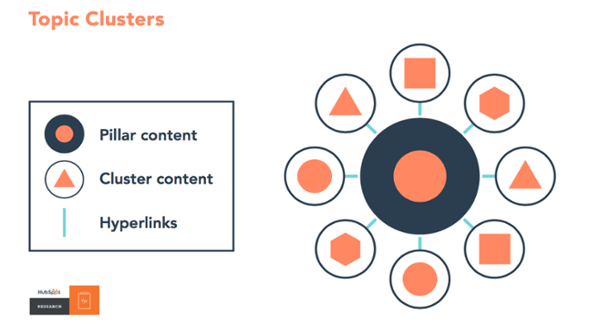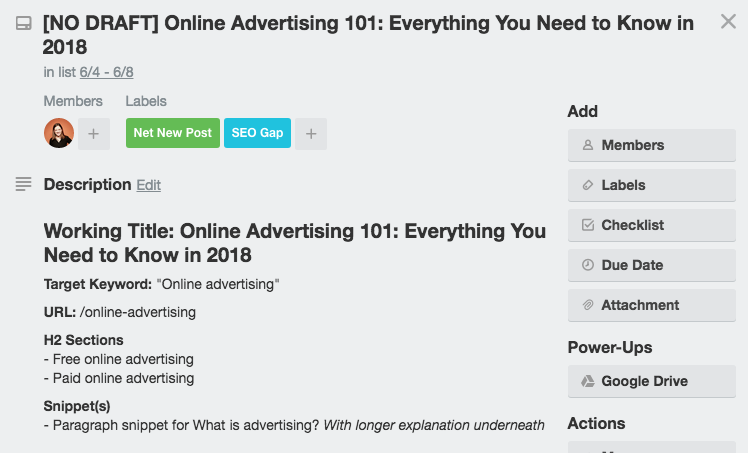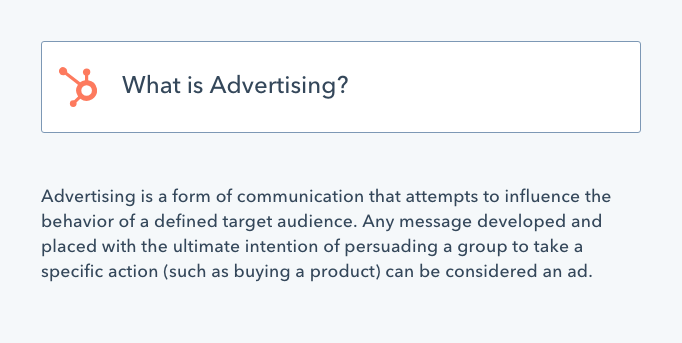When I joined the HubSpot Blog team in 2016, our editorial strategy looked drastically different than it does now.
About once a month, our entire team would gather in a conference room for a brainstorm session. Armed with coffee and spreadsheets full of topic pitches, we'd spend a few hours going around the room, discussing what we wanted to cover for the month. At the end of the meeting, we'd leave with a solid list of articles to get started on.
For a long time, this process served our interests well. Our team developed a keen sense of what our audience wanted to read, and an extensive knowledge of what we'd already covered. But as our property grew and our audience expanded, it became clear that something was missing.
We could no longer manage our archives and identify topic gaps (areas we haven't yet covered on the blog) by gut feeling alone. Although we had some processes in place to pinpoint gaps and select pieces for historical optimization on an article-by-article basis, none of these methods were scalable or precise enough to keep up with what our readers were searching for -- and those issues starting catching up with us.
Rediscovering our momentum meant completely changing the way we plan, write, and optimize content. In March 2018, we started to see the impact of these changes: a new all-time traffic record across our three blogs -- Marketing, Sales, and Service -- and a renewed sense of purpose for the future. After months of traffic plateaus and uncertainty, we know where we're headed now -- and we're ready to share our new strategy with you.
The Blog Traffic Plateau of 2017
I won't sugarcoat it: 2017 was a tough year to be a blogger. Between 2014 and 2016, we'd become accustomed to seeing month-over-month traffic growth without regularly switching up our strategy. When 2017 hit, that line started to flatten out, and then -- even more alarming -- decline. And it wasn’t just us -- Unbounce, Wordstream, and WordPress all saw some form of traffic decrease in 2017.

Traffic to the HubSpot Blog 2014 - 2017
To say we were confused would be an understatement. Up to this point, we thought we'd perfected the formula for sustainable traffic growth: Traffic from existing posts in organic search + new traffic from new posts = steadily increasing traffic, forever … right?
It turns out it wasn't nearly that simple. Our usual protocol for fixing a slump -- changing publishing volume, leaning into more clickable topics, historically optimizing a handful of our heavy-hitting posts -- wasn't having a significant impact. This downward trend wasn't just a temporary dip in our numbers -- it was starting to look like the new normal.
So we did what any good content marketing team would do, and cracked open our reporting dashboards to take a deeper look. Unfortunately, what we discovered after many hours of analysis and many coffees consumed wasn't comforting. Much like the factors behind the mysterious decline of the bee population, there seemed to be multiple culprits converging to create a disaster.
We'd gone looking for a single root cause, and found several macro trends instead:
1. Social algorithms (and users) love native content.
Social media has long been a (relatively) dependable distribution channel for digital publishers, but recent algorithm changes across multiple social networks increasingly favor native content over links that take users off site. The shift makes perfect sense from the social networks' perspectives -- they want users to spend as much time as possible on their network -- but it hurts publishers who depend on social traffic.
2. Conversational search is constantly improving.
Google has gotten a lot better at understanding the intent behind a specific query, and as a result, they're able to serve up extremely relevant pieces of content to meet your exact query. This is great news if you regularly use a home assistant device, but bad news if you're a publisher looking to capture organic traffic from multiple long-tail keywords with a single, comprehensive piece of content.
Back in 2012, a post on "The Best Interview Questions" might have appeared as a top result in searches for "great interview questions," "interview questions to ask an interviewer," and "what questions to ask during an interview." But in 2018, those long-tail search queries are more likely to result in entirely different SERPs with entirely different top results. This means many of our "ultimate guides" started ranking for fewer long-tail keywords, resulting in organic traffic losses on some of our most highly-trafficked pieces.
3. Featured snippets and other on-page search features are taking a toll on CTR from SERPs.
You're probably familiar with Google's featured snippets: those short lists or paragraphs that appear at the top of a SERP and (usually) directly address your query. In addition to featured snippets, there are also a number of other on-page search features that push a piece of content ranking number one even further down your screen.
While these quick answers have certainly made the search experience faster for users, they're eating our organic traffic -- even on SERPs where we hold the number one organic result. People don't have any reason to click through to a blog post (even if it's ranking number one) if the answer they're seeking is already on the top of the SERP. As a result, fewer users are clicking on the number one organic result. Ahrefs found that on SERPs without a featured snippet, the top result received 26% of clicks. When a featured snippet appeared on the SERP, the top result received only 19.6% of clicks.
None of these were things we could fix with a band-aid solution. These shifts called for a massive overhaul of our editorial strategy, and a completely new way of approaching blogging in general.
Our New Editorial Strategy
While these trends were scary for the future of our blog, they weren't entirely surprising. We'd been aware for a while that future-proofing for Google algorithm changes meant restructuring our site architecture. Back in late 2016, Leslie Ye had begun the tedious and challenging work of transitioning the blog's internal linking system into a pillar-cluster model. This move was intended to give us an organized way to understand our content gaps, and a cleaner architecture to help posts rank faster and bring in more organic traffic.
Thanks to a blog redesign project (headed up by Carly Stec) that automated this pillar-clustering process across the entire blog, our 10,000+ posts were neatly sorted into the pillar-cluster model by mid-2017. But our process for planning and writing new content hadn't fully adjusted to work optimally within this new system. We had a much better understanding of where our content gaps were, but we weren't filling these gaps systematically -- we were still largely guessing when it came to the topics we should be writing about on a monthly basis.
We were also suffering from a lack of foresight: we weren't planning for the search terms that would be popular a few years or even a few months into the future. This left room for other blogs and publications to capture organic green space that would be essential to our sustained growth down the line.
With this in mind, we made the decision to focus all our efforts behind stabilizing and growing our organic traffic. If our existing content was slowly but surely losing clicks to featured snippets in search, and our new content wasn't consistently earning as much traffic from promotional channels like social, we needed to offset those losses. And that meant zeroing in on organic green space in a big way.
This led us to create three guidelines we now use to determine what net new content we create:
- Does this topic have search volume, or will have search volume in the future?
- Does it fit into our pillar-cluster model?
- Is it duplicative (is there a piece of content on this topic that already exists)?
If no one is searching for a topic, and we don't anticipate the search demand to grow in the foreseeable future, there's no long-term benefit in covering it. At least for our blog, posts created without a clear keyword in mind tend not to produce sustainable traffic after their first month of publication.
To rank these days, your site usually needs both depth and breadth on a topic -- in other words, you need to cover a concept or subject at a high level, then dive deeper with specific, detailed posts. Using the pillar-cluster model (more on that here) makes our content much likelier to rank than if we published an individual post that targeted one or two keywords. If a blog post doesn't fit into an existing cluster, it's probably not worth our time and energy to write it.

As you can probably imagine, we've covered quite a bit of ground in our 10+ years as a blog. Some overlap is inevitable, but writing on the same exact topic more than once -- even if the takeaways are ultimately different -- can lead to self-competition in the SERPs. And if we’re already ranking highly for a topic, our efforts are better spent creating a piece of content for a SERP we’re not on at all instead of piling on where we already have valuable real estate.
If a topic doesn't meet these three guidelines, we won't create content around it. There are a few exceptions of course -- The Marketing Blog's news program (headed up by Amanda Zantal-Wiener) and thought leadership on topics we think our readers need to hear about -- but for the most part, this organic-first strategy represents an enormous shift in the way we plan our editorial calendar and create content. Posts created with an organic goal in mind don't always pay off immediately, but organic is the only type of traffic that can consistently pay off month over month.
The Editorial Process in Action
Adopting an aggressive organic-first approach required a serious mindset change for our team -- one that required us to put aside our obsession (some would even say addiction) with quick wins, and instead put our primary focus on sowing seeds for the future. We weren't going to publish a post with no strategic organic potential, even if we knew it would bring in a satisfying spike in traffic.
Ultimately, the temporary traffic from a quick-win post brought us nothing of value in the long run. To truly grow, we need to keep our eyes on the organic gaps in our pillar cluster model.
A big part of seeding for the future also means educating ourselves on emerging topics: subjects our readers aren't too concerned with right now but that will eventually become trending search terms, like the nuts and bolts of artificial intelligence, or practical applications for blockchain. These are the technologies people will likely be searching for in droves in the future, and we want to get out ahead of the competition and position our blog as a resource right now -- and earn the traffic when the search volume spikes.
So how exactly do we select which topics to cover? We've talked about the reasons behind our new strategy, now let's see what this process actually looks like on a quarterly basis.
Stage One: Planning
We've partnered internally with our SEO team to create a blog taskforce of sorts, headed up by our former Sales Blog Editor and current Sr. SEO Strategist Aja Frost. Each quarter, Aja conducts in-depth keyword research across our three onsite blog properties (Marketing, Sales, and Service), taking into account both gaps in our existing topic clusters, and emerging topics we haven't yet thoroughly constructed content clusters around.
The resulting quarterly report includes well over 100 post suggestions broken down by topic clusters for each blog. Here's what our completed "Advertising" cluster looks like on the report:

Stage Two: Execution
Our Multimedia Content Strategy team handles the creation of each cluster's pillar page (the long-form piece of content that serves as a broad, foundational resource on the subject), and the Blog team owns the production of the supporting blog articles that delve deeper into specific subtopics. Most of the articles need to be written from scratch, but in some cases, we already have a blog post in existence that just needs to be updated to include a fresher, more exhaustive take on the subject.
SEO optimization has always been a consideration for our team when writing posts, but under this new strategy, its become a top priority. Before a single word is typed on a first draft, our writers already have information from our SEO team on the keyword(s) to target, section titles (H2s) to include, and featured snippet sections to work into the copy.
Here's an example of a typical article assignment on our editorial calendar:

Targeting featured snippets with consistently formatted sections has removed some (but definitely not all) of the guesswork when it comes to ranking for featured snippets. Matthew Howells-Barby, HubSpot’s Director of Acquisition, has stressed that clean and consistent code is a significant factor in winning snippets.
His team created a simple code our writers can use when formatting sections of copy for paragraph or list snippets. Not only has our team started incorporating featured snippet sections into all our new posts, but we've also historically "snippetized" hundreds of posts from our archives to help Google surface them more frequently.
If you're a regular reader of our blog, you've likely encountered these snippet boxes before:

While there's unfortunately not a 100% guaranteed formula to win featured snippets, this method has helped our team capture more than 6,300 featured snippets as of June 2018.
In addition to optimizing our articles more intentionally for featured snippets, we've also adopted a more aggressive historical optimization approach in 2018. Our team has had a historical optimization strategy in place for several years now, but it’s been years since we’ve had a full-time human dedicated to making sure our existing content is performing optimally in search.
Braden Becker, a Senior Staff Writer on the Blog team, has taken on the task of monitoring the organic performance and optimization of our 10+ years worth of archives as a full-time responsibility. Each month, Braden works with our SEO team to develop an update strategy that works with the new content clusters we're producing. He selects posts for updating largely based on their individual monthly organic traffic -- "the better they're performing, the higher the potential benefit once I optimize them," he explains.
Stage Three: Analyze
Once a month, the Content and SEO teams meet to discuss our progress, dig into the numbers, and plan for the next few weeks. We examine organic traffic numbers across our three blog properties, report on featured snippet attainment and loss, and discuss new ways we can adapt to Google's ever-changing algorithm.
The biggest shift in our reporting method under our new organic-first strategy has been a mental (and, I'll say it, emotional) one. Although we still report at a monthly cadence, we've had to largely abandon our fixation with month-over-month growth, and instead focus on broader trends over longer periods of time.
When I first joined the Blog team, month-over-month growth was the ultimate goal. If the end-of-month traffic number beat out the previous month, we considered it a success; if that number was in the red -- a lost month. No matter what, the slate was wiped clean on the first day of the next month, and we started the race all over again. This short-term mentality led us to become so focused on hitting monthly numbers, we ended up neglecting the bigger picture: our blog's health and continued growth over time. Enter the traffic plateau of 2017.
Under our new editorial strategy, we're more focused on seeding for the future -- and that means letting go of our monthly traffic goals. An article we publish this month on "How to Create a Content Marketing Strategy for Virtual Reality" might not have a ton of search volume right now, but we're betting it will sometime in the future. It might be many months before we see the rewards reflected in our traffic numbers, and we have to be okay with waiting, knowing we're setting ourselves up well for the future.
As a result of this strategy, our team's mindset has gone from "We'll do anything to smash our monthly traffic goals" to "Stick to the plan."
Getting out in front of future search terms and filling gaps in our existing topic cluster structure will pay off more than watching the monthly traffic numbers rise over a few well-timed, clickable posts.
What challenges is your blog facing? How are you approaching growth in 2018? Talk to us @HubSpot.




![How Often Should You (or Your Company) Blog? [New Data]](https://53.fs1.hubspotusercontent-na1.net/hubfs/53/img-1-20250522-1717852.webp)








